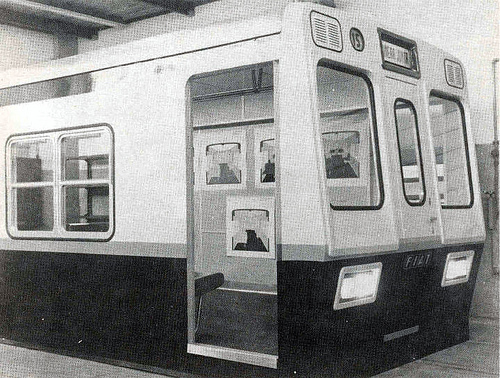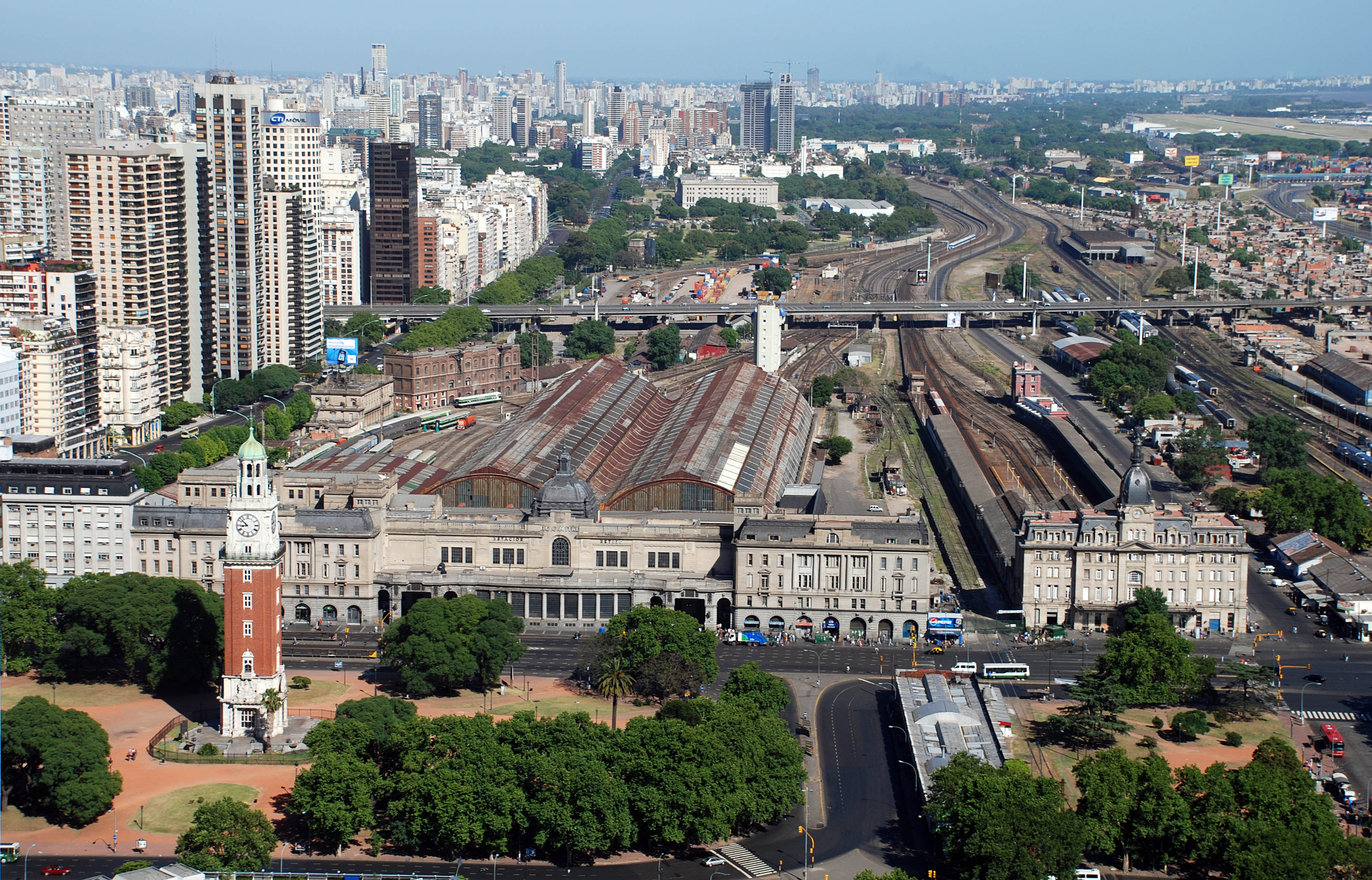|
Line E (Buenos Aires Metro)
Line E of the Buenos Aires Underground runs from Retiro to Plaza de los Virreyes, a total distance of 12 km. Opened in 1944, the Line E was the last completely new line to be added to the Buenos Aires Underground, until 2007 when Line H was opened. The line has a history of being re-routed and extended due to having been historically the line with the lowest passenger numbers on the network. History Line E was opened on 20 June 1944, after construction began in 1938, with an original route that ran from Constitución railway station to General Urquiza. Soon after, it was decided to abandon the terminus at Constitución (which also served as the connection with Line C) and instead reroute the line towards the Plaza de Mayo. Work began in 1957, and in 1966 the San José, Independencia, Belgrano and Plaza de Mayo (now Bolívar) stations were opened to the public by president Arturo Umberto Illia. For many years, the two stations that had been closed as a result of th ... [...More Info...] [...Related Items...] OR: [Wikipedia] [Google] [Baidu] |
Línea E (SBASE) Bullet
A linea is any long marking, dark or bright, on a planet or moon's surface. Linea may also refer to: * Fiat Linea, small family car released in 2007 * Linea (''Stargate''), character in the TV series * Línea Spanish customary units ;Anatomy: * Linea alba (abdomen), fibrous structure that runs down the midline of the abdomen * Linea alba (cheek), horizontal streak on the mucosal surface of the cheek * Linea aspera, ridge of roughened surface on the posterior aspect of the femur * Linea nigra, dark vertical line that appears on the abdomen during pregnancy * Linea semilunaris, curved tendinous line placed one on either side of the rectus abdominis. * Linea terminalis or innominate line, consists of the pectineal line, the pubic crest and the arcuate line. See also * La Linea (other) * Linea 77, Italian nu metal band formed in 1993 * '' Buccinulum linea linea'', lined whelk * Linea Søgaard-Lidell Linea Søgaard-Lidell (born 30 March 1987) is a Danish politician. Po ... [...More Info...] [...Related Items...] OR: [Wikipedia] [Google] [Baidu] |
Bolívar (Buenos Aires Underground)
Bolívar is a station on Line E of the Buenos Aires Underground at is located on the Diagonal Sur avenue by the Plaza de Mayo The Plaza de Mayo (; en, May Square) is a city square and main foundational site of Buenos Aires, Argentina. It was formed in 1884 after the demolition of the Recova building, unifying the city's Plaza Mayor and Plaza de Armas, by that time know .... Subterráneos de Buenos Aires S.E. From here, passengers may transfer to the Perú Station on Line A and the [...More Info...] [...Related Items...] OR: [Wikipedia] [Google] [Baidu] |
Alstom
Alstom SA is a French multinational rolling stock manufacturer operating worldwide in rail transport markets, active in the fields of passenger transportation, signalling, and locomotives, with products including the AGV, TGV, Eurostar, Avelia and New Pendolino high-speed trains, in addition to suburban, regional and metro trains, and Citadis trams. Alsthom (originally Als-Thom) was formed by a merger between Compagnie Française Thomson-Houston and the electric engineering division of Société Alsacienne de Constructions Mécaniques in 1928. Significant later acquisitions included the Constructions Electriques de France (1932), shipbuilder Chantiers de l'Atlantique (1976), and parts of ACEC (Belgium, late-1980s). A merger with parts of the General Electric Company (UK) formed GEC Alsthom in 1989. Throughout the 1990s, the company expanded its holdings in the rail sector, via the acquisition of German rolling stock manufacturer Linke-Hofmann-Busch and Italian rail signall ... [...More Info...] [...Related Items...] OR: [Wikipedia] [Google] [Baidu] |
Emepa Group
Emepa Group S.A. ( es, Grupo Emepa, an acronym for Empresa Metalúrgica Patricias Argentinas)Gabriel Romero, el mítico surfer radical de la Hidrovía by Diego Genoud on Letra P, Feb 2021 is an manufacturer of vehicles and owner of (which operates on the |
Fiat-Materfer (Buenos Aires Underground)
The Fiat-Materfer Buenos Aires Underground rolling stock was built by the Argentine company Materfer - then a subsidiary of Fiat Ferroviaria - beginning in 1980 and continuing on through that decade. It was originally conceived to standardise the diverse rolling stock of the Buenos Aires Underground with the use of one model throughout all the lines. However, with the economic and political turmoil faced in the country during and following the collapse of the National Reorganisation Process junta in 1983, its production ended up being far more limited. During the 2010s, the cars were used as temporary stock for two lines, being phased out as newer models arrived from overseas. History and overview By the late 1970s, the Buenos Aires Underground had a vast array of ageing rolling stock. This was because the different lines were developed by different companies in different periods. Yet the need for standardisation was becoming apparent given the increased cost of dealing with so ... [...More Info...] [...Related Items...] OR: [Wikipedia] [Google] [Baidu] |
Siemens-Schuckert Orenstein & Koppel
The Siemens-Schuckert Orenstein & Koppel (normally abbreviated to Siemens O&K) is an underground car formerly used on the Buenos Aires Underground first built by Siemens-Schuckert and Orenstein & Koppel in 1934, 1937 and 1944 with a smaller number of cars built in Argentina during the 1950s. The Siemens O&K rolling stock made up the entirety of the trains used on the three lines built by the Hispanic-Argentine Company for Public Works and Finances (CHADOPyF) and has since served on every line of the Underground (with the exception of Line B, which uses third rail electrification) from 1934 to 2016, with cars refurbished by the Emepa Group and Alstom continued to function on the network till 2017. As such, it has been the most widely used rolling stock in the Underground's history, and second only to the Brugeoise cars in the number of years served, being the oldest cars in circulation at the time of their retirement in 2016. History The first Siemens-Schuckert Orenstein & Ko ... [...More Info...] [...Related Items...] OR: [Wikipedia] [Google] [Baidu] |
Mitre Line
The Mitre line is an Argentine broad gauge commuter rail service in Buenos Aires Province and is part of the Ferrocarril General Bartolomé Mitre division. The service is currently operated by the State-owned company Operadora Ferroviaria Sociedad del Estado after the Government of Argentina rescinded its contract with Corredores Ferroviarios in March 2015. History Background The first line was built and operated by the Buenos Aires Northern Railway, a British-owned company that ran trains from Central Station (then from Retiro) to Tigre, joining both cities in 1857. The company was then taken over by the Central Argentine Railway in 1888 due to financial problems. In 1891, Victoria station was inaugurated. Trains to Zelaya and Capilla del Señor departed from Victoria for the first time one year later. In 1916, the Retiro- Tigre line was electrified, becoming the first electrified railway system in South America. New British Thomson-Houston (BTH) multiple units were acquir ... [...More Info...] [...Related Items...] OR: [Wikipedia] [Google] [Baidu] |
Correo Central (Buenos Aires Underground)
Correo Central is a station on Line E of the Buenos Aires Underground The Buenos Aires Underground ( es, Subterráneo de Buenos Aires, links=no), locally known as Subte (), is a rapid transit system that serves the area of the city of Buenos Aires, Argentina. The first section of this network (Plaza de Mayo–Pla .... Passengers are able to transfer to the Leandro N. Alem Station on Line B. The site is located in the ''barrio'' of San Nicolás and the station is situated underneath the Néstor Kirchner Cultural Centre. The station was opened on 3 June 2019 as part of the extension of the line from Bolívar to Retiro. References External links Buenos Aires Underground stations {{BuenosAires-underground-stub ... [...More Info...] [...Related Items...] OR: [Wikipedia] [Google] [Baidu] |
Catalinas (Buenos Aires Underground)
Catalinas is a station on Line E of the Buenos Aires Underground The Buenos Aires Underground ( es, Subterráneo de Buenos Aires, links=no), locally known as Subte (), is a rapid transit system that serves the area of the city of Buenos Aires, Argentina. The first section of this network (Plaza de Mayo–Plaz .... The station was opened on 3 June 2019 as part of the extension of the line from Bolívar to Retiro. References Buenos Aires Underground stations {{BuenosAires-underground-stub ... [...More Info...] [...Related Items...] OR: [Wikipedia] [Google] [Baidu] |
Retiro Railway Station
Retiro is the name of a railway station complex in Buenos Aires, Argentina, that includes three main terminal train stations ( Retiro-Mitre, Retiro-Belgrano and Retiro-San Martín) and two terminal subway stations ( Retiro of Line C and Retiro of Line E). The complex is named after the neighborhood where it is located, Retiro. It is close to Retiro Bus Terminal Station, the country´s biggest bus terminal. Overview The stations are very close to the Retiro bus station (''Terminal de Omnibus''), the principal long-distance bus terminal in Buenos Aires. The complex is also accessible by the C line of the Buenos Aires Metro system and by numerous local public bus services. The stations will also be accessible by both Line E and Line H of the metro once their extensions are complete. Three stations are located opposite Plaza San Martín, a large park. Services Commuter rail Retiro is the largest railway complex in Buenos Aires and more commuter trains arrive and depa ... [...More Info...] [...Related Items...] OR: [Wikipedia] [Google] [Baidu] |
Premetro
A premetro is a tramway or light railway which includes segments built to rapid transit standards, generally as part of a process of conversion to a metro-standards railway usually by the construction of tunnels in the central city area. History The first city to carry a portion of a streetcar line through the city center in a tunnel was Marseille, France, in 1893, with its Noailles subterranean station (see Marseille tramway). It was initially operated by horse-drawn wagons. The next prominent example was the Tremont Street subway (1897) in Boston, today part of the MBTA Green Line. These early tunnels were intended solely to reduce streetcar congestion on surface streets, not for later conversion to metro service. Several early streetcar tunnels, including the Steinway Tunnel and East Boston Tunnel, were later converted to metro operation. However, the small loading gauge, tight curves, and steep grades of the streetcar tunnels required smaller metro cars than otherwise desi ... [...More Info...] [...Related Items...] OR: [Wikipedia] [Google] [Baidu] |





_-_01.jpg)